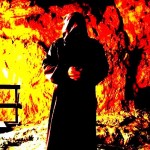 by John Sanidopoulos
by John Sanidopoulos
Having done my Master’s thesis on the Bogomil heretics, I offer the following information regarding a little known controversy of the status of the Three Hierarchs between the Bogomils and the Orthodox during the time when the more well-known controversy was occurring in Constantinople that lead to the feast we celebrate on January 30th.
The Three Hierarchs Controversy in Constantinople
During the reign of Emperor Alexios I Komnenos (1081 – 1118) there arose in Constantinople a great dispute over these three hierarchs. Some regarded Basil the Great (c. 330-379) higher than the other three because he was an exalted orator, he surpassed all in his time in both word and deed, he was angelic, steadfast in temperament, and alien to all that is worldly. Others regarded John Chrysostom (c. 347-407) for being most loving and merciful, understanding the weaknesses of human nature, and as an eloquent orator who guided all to repentance through his discourses. Others, finally, stood behind Gregory the Theologian (329-389) maintaining that in the cogency of his speech, his skillful interpretation of the Scriptures and in the elegance of the construction of his discourses he surpassed all the renowned proponents of Hellenic wisdom, both those who lived in times past and those who were his contemporaries. Thus, while others would exalt the glory of one Church Father, others would demean their significance. Some went so far as to refer to themselves as Basilians, Johnites and Gregorians.
After a short time these three Saints appeared in a vision to Metropolitan John Mauropous of Euchaita (died c. 1075-1081), who recorded the details of this controversy (PG 120). He was told in this vision by the three hierarchs themselves that all three of them were equal before God and commanded that those indulging in the disputes to cease their disagreements and unite by commemorating the three together on a single day and ordered that Bishop John write the hymns for the feast. Since all three were commemorated in January, he decided to proclaim the Feast of the Three Hierarchs on January 30th, and this ended the dispute. (See The Lives of the Three Great Hierarchs: Basil the great, Gregory the Theologian, and John Chrysostom. Dormition Skete Publications, 1985, pp. 188-191.)
The Bogomils and the Three Hierarchs
It was not only among the Orthodox that a controversy at this time existed regarding the Three Hierarchs. It seems that it was a short time after the institution of this feast that Basil, the ascetical leader of the Bogomil heretics, entered Constantinople with his twelve disciples seeking to convert the Orthodox to their heresy. The Alexiad of Anna Komnena describes the meeting between Basil and her father, Emperor Alexios I Komnenos, who tried through argument and intimidation to bring Basil to Orthodoxy. Basil’s defiant belief that God would deliver him even if he were thrown in a pit of fire prompted the emperor to test this claim by having him burnt in the Hippodrome.
While Basil was in prison, the emperor sent a renowned dogmatician and apologist, the monk Euthymios Zygabenos, to interview him about his beliefs and expose his gross heresies. Zygabenos recorded all this in his masterpiece titled The Dogmatic Panoply (PG 130). Among his many errors, Basil revealed his abhorrence for the Three Hierarchs, especially St. John Chrysostom whom the Bogomils called “John the Swollen Mouth”. The Bogomils considered Chrysostom as a corrupter of the original New Testament by heading a conspiracy to remove important passages from the Gospels that in reality were interpolated by the Bogomils.
In his chapter “On the Bogomils”, Zygabenos also offers a commentary on how the Bogomils interpreted specific passages from the Gospel of Matthew along with his own critique. Regarding Matthew 7:15 which reads
“Beware of false prophets who come to you in sheep’s clothing, but inwardly are ravening wolves”,
Zygabenos informs us of the following way in which the Bogomils interpreted this passage:
“They say that a false prophet – how absurd – means Basil, who was great in teaching, and Gregory the star of theology, and John Chrysostom, because they taught the revealed doctrine. I leave out the other absurdities of the sect, which they utter against these Saints more than the rest, and which deserve thunder and a chasm and punishment of every sort.”
Both controversies were occurring at the same time and it appears the Bogomils possibly wanted their own opinion heard by not honoring any of the Three Hierarchs and demeaning their memory altogether. Or it merely shows how highly the Orthodox regarded the Three Hierarchs at this time, considering therefore that a war against the Three Hierarchs was a war against Orthodoxy. It is possible that the controversy among the Orthodox may have begun by Bogomils, since Cosmas the Bulgarian says a century earlier that the Bogomils of Bulgaria blamed John Chrysostom for introducing the corrupted doctrine of the Eucharist through his Liturgy.
When Basil the Bogomil was burned to death in the Hippodrome, it was not long thereafter that the influence of Bogomilism was eradicated from Constantinople, thanks to the efforts of Emperor Alexios I.
